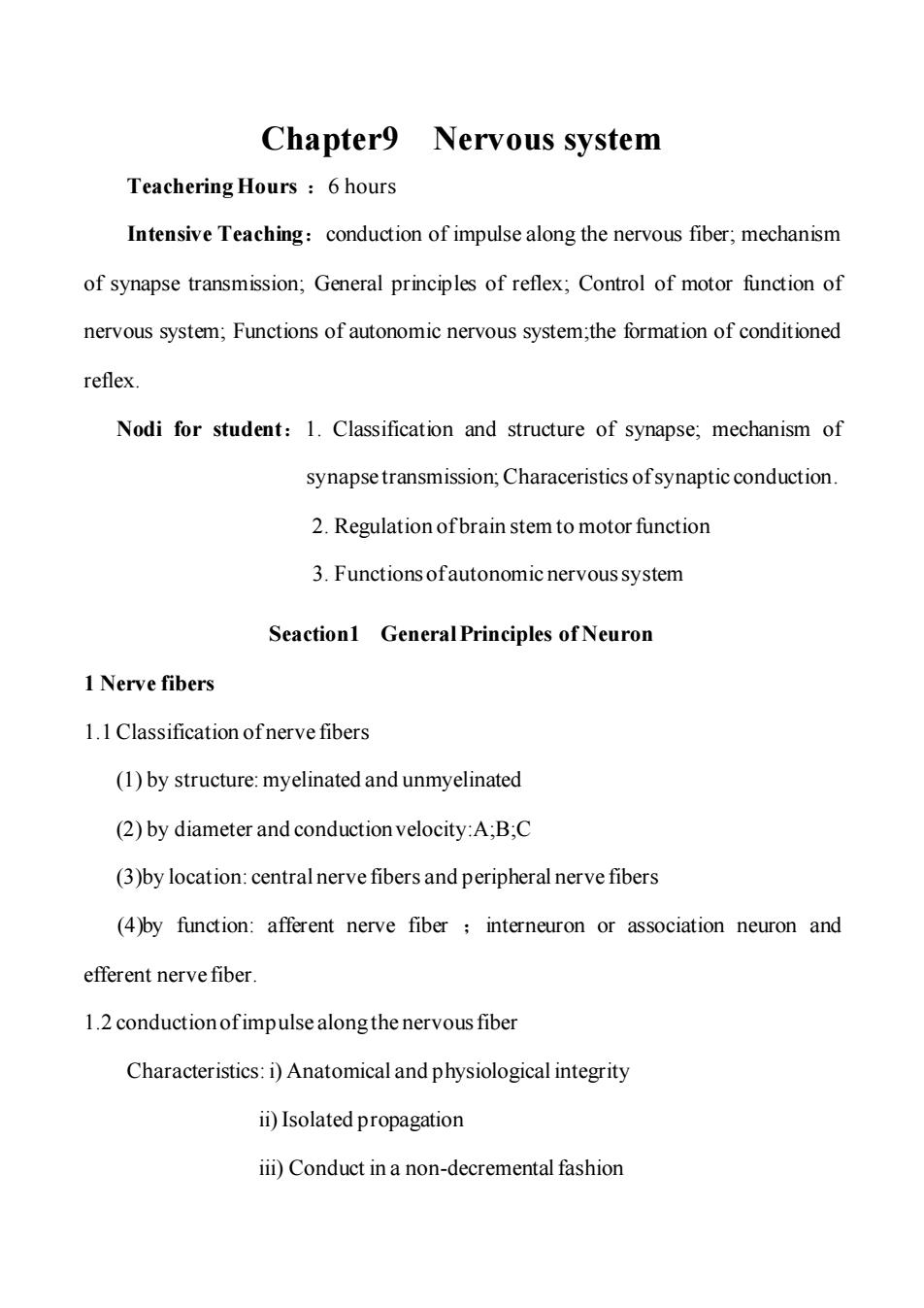
Chapter9 Nervous system Teachering Hours 6 hours Intensive Teaching:conduction of impulse along the nervous fiber;mechanism of synapse transmission;General principles of reflex;Control of motor function of nervous system;Functions of autonomic nervous system;the formation of conditioned reflex. Nodi for student:1.Classification and structure of synapse;mechanism of synapse transmission;Characeristics ofsynaptic conduction. 2.Regulation ofbrain stem to motor function 3.Functions ofautonomic nervous system Seaction1 General Principles of Neuron 1 Nerve fibers 1.1 Classification ofnerve fibers (1)by structure:myelinated and unmyelinated (2)by diameter and conduction velocity:A;B;C (3)by location:central nerve fibers and peripheral nerve fibers (4by function:afferent nerve fiber interneuron or association neuron and efferent nerve fiber. 1.2 conduction ofimpulse along the nervous fiber Characteristics:i)Anatomical and physiological integrity ii)Isolated propagation iii)Conduct in a non-decremental fashion
Chapter9 Nervous system Teachering Hours :6 hours Intensive Teaching:conduction of impulse along the nervous fiber; mechanism of synapse transmission; General principles of reflex; Control of motor function of nervous system; Functions of autonomic nervous system;the formation of conditioned reflex. Nodi for student:1. Classification and structure of synapse; mechanism of synapse transmission;Characeristics of synaptic conduction. 2. Regulation of brain stem to motor function 3. Functions of autonomic nervous system Seaction1 General Principles of Neuron 1 Nerve fibers 1.1 Classification of nerve fibers (1) by structure: myelinated and unmyelinated (2) by diameter and conduction velocity:A;B;C (3)by location: central nerve fibers and peripheral nerve fibers (4)by function: afferent nerve fiber ;interneuron or association neuron and efferent nerve fiber. 1.2 conduction of impulse along the nervous fiber Characteristics: i) Anatomical and physiological integrity ii) Isolated propagation iii) Conduct in a non-decremental fashion

iv)Bidirectional propagation v)Relative indefatigability 2.Synapse and synapse transmission Synapse:The structure where an axon or axon branches ends on the soma,dendrites and axon ofanother neuron is called a synapse. 2.1 Classification ofsynapse Chemical synapse;electrical synapse 2.2 structure ofsynapse Presynaptic terminal Synaptic cleft Postsynaptic membrane 2.3 Chemical synapse transmission (1)EPSP: Excitary transmitter-Synaptic cleft -bind to receptors increases the membrane's permeability to all ions-sodium,potassium and chloride cross the membrane of the postsynaptic,mainly Na+enters the postsynaptic neuron- depolarizing potential is produced. (2)IPSP The inhibitory neurotransmitters increase the permeability of the postsynaptic membrane only to potassium and chloride,mainly chlorides but not Na+.The chlorides enter the postsynaptic neuron,and the hyperpolarizing potential is produced. 2.4 Characeristics ofsynaptic conduction
iv) Bidirectional propagation v) Relative indefatigability 2. Synapse and synapse transmission Synapse: The structure where an axon or axon branches ends on the soma, dendrites and axon of another neuron is called a synapse. 2.1 Classification of synapse Chemical synapse; electrical synapse 2.2 structure of synapse Presynaptic terminal Synaptic cleft Postsynapticmembrane 2.3 Chemical synapse transmission (1)EPSP: Excitary transmitter → Synaptic cleft → bind to receptors → increases the membrane's permeability to all ions → sodium, potassium and chloride cross the membrane of the postsynaptic, mainly Na+ enters the postsynaptic neuron → depolarizing potential is produced. (2) IPSP The inhibitory neurotransmitters increase the permeability of the postsynaptic membrane only to potassium and chloride, mainly chlorides but not Na+. The chlorides enter the postsynaptic neuron, and the hyperpolarizing potential is produced. 2.4 Characeristics of synaptic conduction
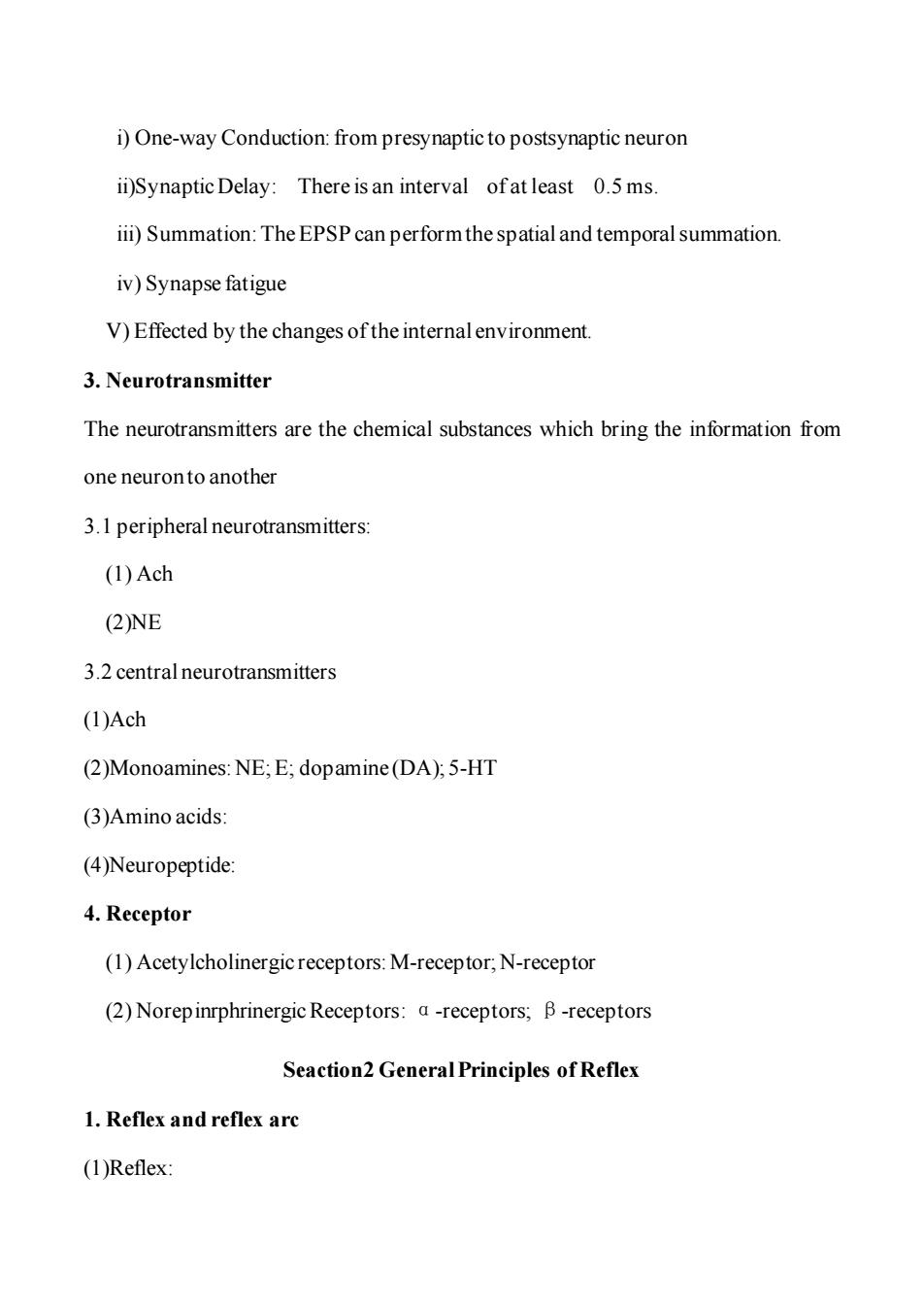
i)One-way Conduction:from presynaptic to postsynaptic neuron ii)Synaptic Delay:There is an interval ofat least 0.5 ms. iii)Summation:The EPSP can perform the spatial and temporal summation. iv)Synapse fatigue V)Effected by the changes of the internal environment. 3.Neurotransmitter The neurotransmitters are the chemical substances which bring the information from one neuron to another 3.1 peripheral neurotransmitters: (1)Ach (2)NE 3.2 central neurotransmitters (1)Ach (2)Monoamines:NE;E;dopamine(DA);5-HT (3)Amino acids: (4)Neuropeptide: 4.Receptor (1)Acetylcholinergic receptors:M-receptor;N-receptor (2)Norepinrphrinergic Receptors:a -receptors;B-receptors Seaction2 General Principles of Reflex 1.Reflex and reflex arc (1)Reflex:
i) One-way Conduction: from presynaptic to postsynaptic neuron ii)Synaptic Delay: There is an interval of at least 0.5 ms. iii) Summation: The EPSP can perform the spatial and temporal summation. iv) Synapse fatigue V) Effected by the changes of the internal environment. 3. Neurotransmitter The neurotransmitters are the chemical substances which bring the information from one neuron to another 3.1 peripheral neurotransmitters: (1) Ach (2)NE 3.2 central neurotransmitters (1)Ach (2)Monoamines: NE; E; dopamine (DA); 5-HT (3)Amino acids: (4)Neuropeptide: 4. Receptor (1) Acetylcholinergic receptors: M-receptor; N-receptor (2) Norepinrphrinergic Receptors: α-receptors; β-receptors Seaction2 General Principles of Reflex 1. Reflex and reflex arc (1)Reflex:
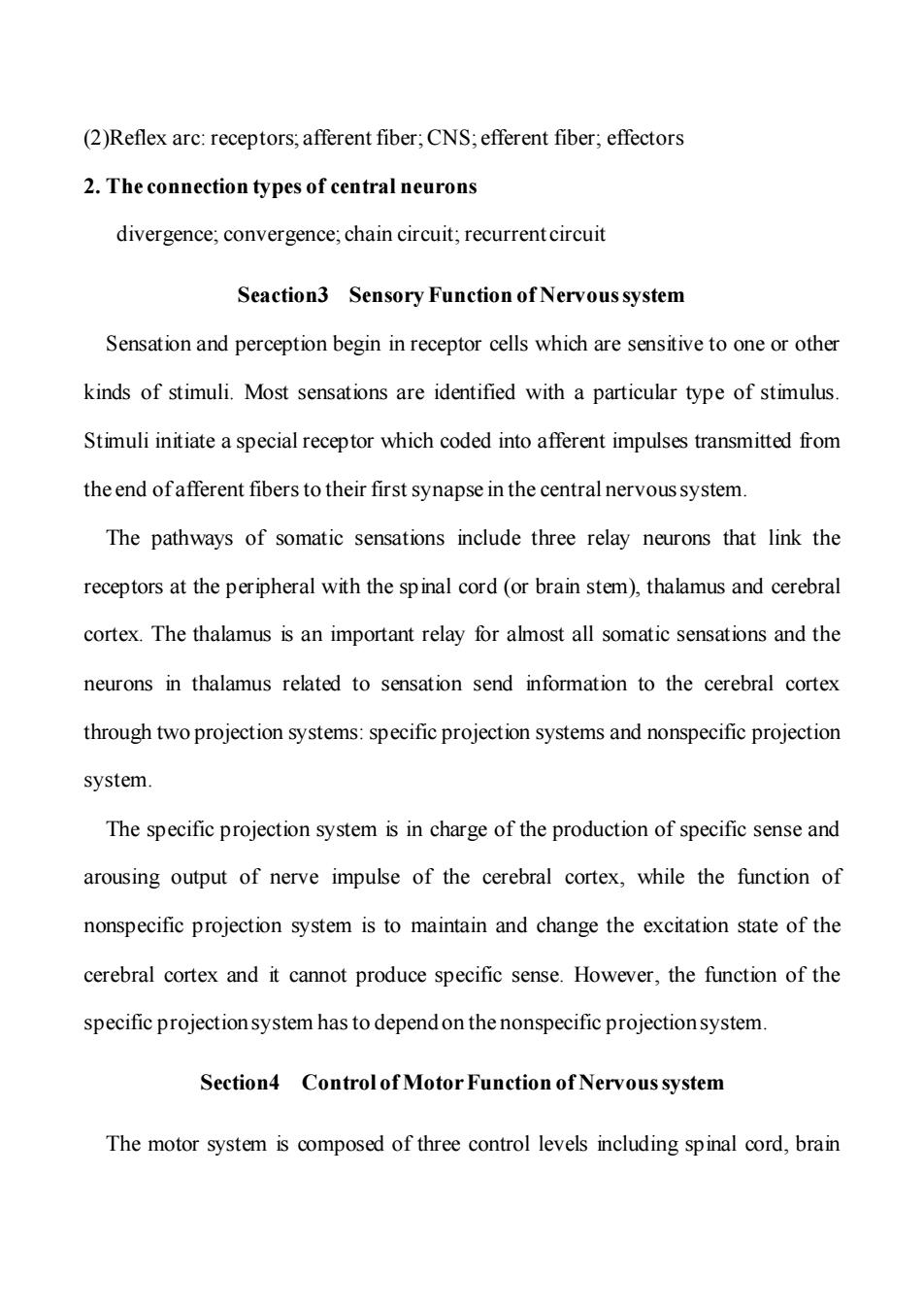
(2)Reflex arc:receptors;afferent fiber:CNS:efferent fiber:effectors 2.The connection types of central neurons divergence;convergence;chain circuit;recurrent circuit Seaction3 Sensory Function of Nervous system Sensation and perception begin in receptor cells which are sensitive to one or other kinds of stimuli.Most sensations are identified with a particular type of stimulus. Stimuli initiate a special receptor which coded into afferent impulses transmitted from the end of afferent fibers to their first synapse in the central nervous system. The pathways of somatic sensations include three relay neurons that link the receptors at the peripheral with the spinal cord (or brain stem),thalamus and cerebral cortex.The thalamus is an important relay for almost all somatic sensations and the neurons in thalamus related to sensation send information to the cerebral cortex through two projection systems:specific projection systems and nonspecific projection system The specific projection system is in charge of the production of specific sense and arousing output of nerve impulse of the cerebral cortex,while the function of nonspecific projection system is to maintain and change the excitation state of the cerebral cortex and it cannot produce specific sense.However,the function of the specific projection system has to depend on the nonspecific projection system. Section4 Control of Motor Function of Nervous system The motor system is composed of three control levels including spinal cord,brain
(2)Reflex arc: receptors; afferent fiber; CNS; efferent fiber; effectors 2. The connection types of central neurons divergence; convergence; chain circuit; recurrent circuit Seaction3 Sensory Function of Nervous system Sensation and perception begin in receptor cells which are sensitive to one or other kinds of stimuli. Most sensations are identified with a particular type of stimulus. Stimuli initiate a special receptor which coded into afferent impulses transmitted from the end of afferent fibers to their first synapse in the central nervous system. The pathways of somatic sensations include three relay neurons that link the receptors at the peripheral with the spinal cord (or brain stem), thalamus and cerebral cortex. The thalamus is an important relay for almost all somatic sensations and the neurons in thalamus related to sensation send information to the cerebral cortex through two projection systems: specific projection systems and nonspecific projection system. The specific projection system is in charge of the production of specific sense and arousing output of nerve impulse of the cerebral cortex, while the function of nonspecific projection system is to maintain and change the excitation state of the cerebral cortex and it cannot produce specific sense. However, the function of the specific projection system has to depend on the nonspecific projection system. Section4 Control of Motor Function of Nervous system The motor system is composed of three control levels including spinal cord, brain
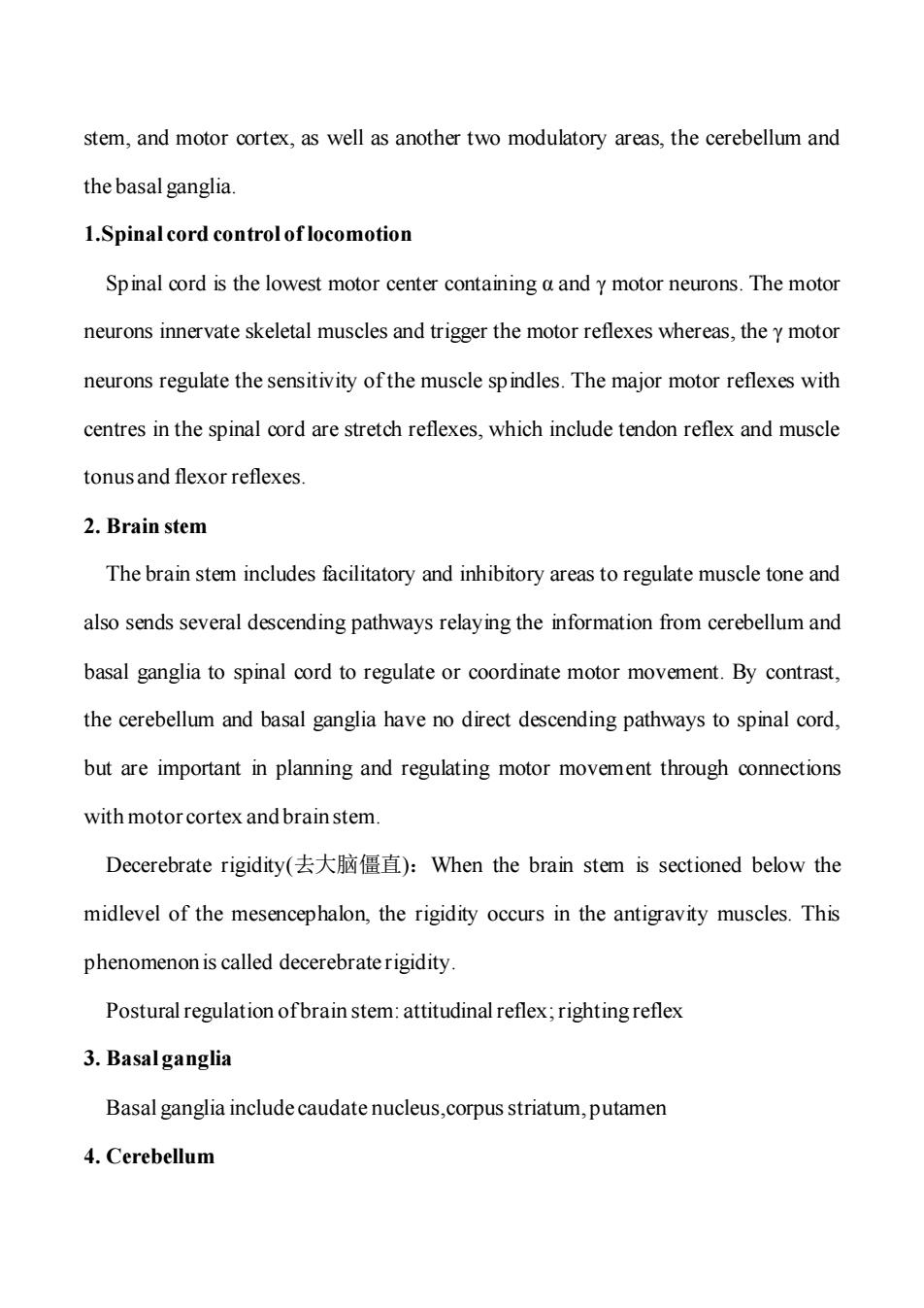
stem,and motor cortex,as well as another two modulatory areas,the cerebellum and the basal ganglia. 1.Spinal cord control oflocomotion Spinal cord is the lowest motor center containing a and y motor neurons.The motor neurons innervate skeletal muscles and trigger the motor reflexes whereas,the y motor neurons regulate the sensitivity of the muscle spindles.The major motor reflexes with centres in the spinal cord are stretch reflexes,which include tendon reflex and muscle tonus and flexor reflexes. 2.Brain stem The brain stem includes facilitatory and inhibitory areas to regulate muscle tone and also sends several descending pathways relaying the information from cerebellum and basal ganglia to spinal cord to regulate or coordinate motor movement.By contrast, the cerebellum and basal ganglia have no direct descending pathways to spinal cord, but are important in planning and regulating motor movement through connections with motor cortex and brain stem Decerebrate rigidity(去大脑僵直):When the brain stem is sectioned below the midlevel of the mesencephalon,the rigidity occurs in the antigravity muscles.This phenomenon is called decerebrate rigidity. Postural regulation ofbrain stem:attitudinal reflex;righting reflex 3.Basal ganglia Basal ganglia include caudate nucleus,corpus striatum,putamen 4.Cerebellum
stem, and motor cortex, as well as another two modulatory areas, the cerebellum and the basal ganglia. 1.Spinal cord control of locomotion Spinal cord is the lowest motor center containing α and γ motor neurons. The motor neurons innervate skeletal muscles and trigger the motor reflexes whereas, the γ motor neurons regulate the sensitivity of the muscle spindles. The major motor reflexes with centres in the spinal cord are stretch reflexes, which include tendon reflex and muscle tonus and flexor reflexes. 2. Brain stem The brain stem includes facilitatory and inhibitory areas to regulate muscle tone and also sends several descending pathways relaying the information from cerebellum and basal ganglia to spinal cord to regulate or coordinate motor movement. By contrast, the cerebellum and basal ganglia have no direct descending pathways to spinal cord, but are important in planning and regulating motor movement through connections with motor cortex and brain stem. Decerebrate rigidity(去大脑僵直):When the brain stem is sectioned below the midlevel of the mesencephalon, the rigidity occurs in the antigravity muscles. This phenomenon is called decerebrate rigidity. Postural regulation of brain stem: attitudinal reflex; righting reflex 3. Basal ganglia Basal ganglia include caudate nucleus,corpus striatum, putamen 4. Cerebellum
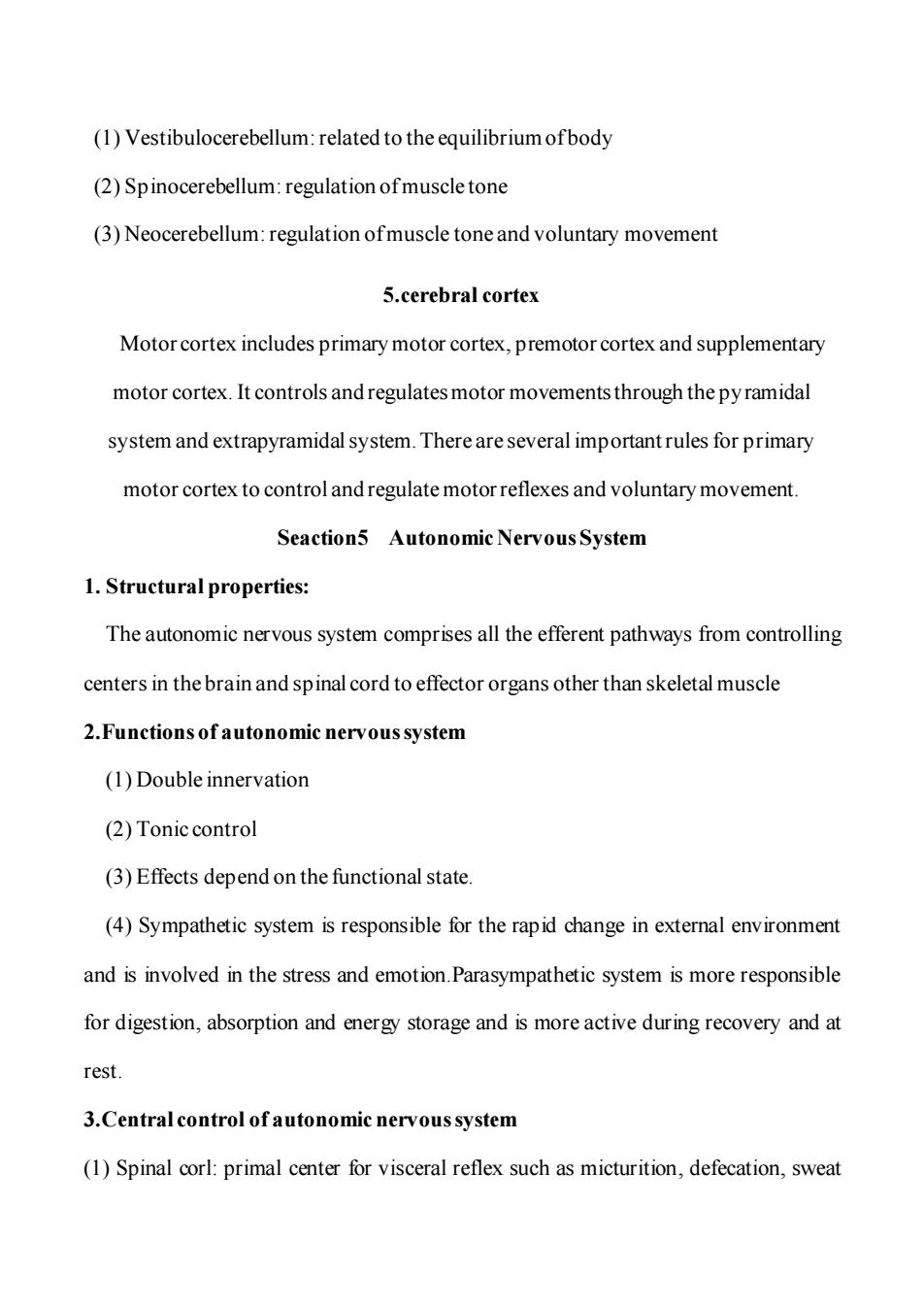
(1)Vestibulocerebellum:related to the equilibrium ofbody (2)Spinocerebellum:regulation ofmuscle tone (3)Neocerebellum:regulation ofmuscle tone and voluntary movement 5.cerebral cortex Motor cortex includes primary motor cortex,premotor cortex and supplementary motor cortex.It controls and regulates motor movements through the py ramidal system and extrapyramidal system.There are several important rules for primary motor cortex to control and regulate motor reflexes and voluntary movement. Seaction5 Autonomic Nervous System 1.Structural properties: The autonomic nervous system comprises all the efferent pathways from controlling centers in the brain and spinal cord to effector organs other than skeletal muscle 2.Functions of autonomic nervous system (1)Double innervation (2)Tonic control (3)Effects depend on the functional state. (4)Sympathetic system is responsible for the rapid change in external environment and is involved in the stress and emotion.Parasympathetic system is more responsible for digestion,absorption and energy storage and is more active during recovery and at rest. 3.Central control of autonomic nervous system (1)Spinal corl:primal center for visceral reflex such as micturition,defecation,sweat
(1) Vestibulocerebellum: related to the equilibriumof body (2) Spinocerebellum: regulation of muscle tone (3) Neocerebellum: regulation of muscle tone and voluntary movement 5.cerebral cortex Motor cortex includes primary motor cortex, premotor cortex and supplementary motor cortex. It controls and regulates motor movements through the pyramidal system and extrapyramidal system. There are several important rules for primary motor cortex to control and regulate motor reflexes and voluntary movement. Seaction5 Autonomic Nervous System 1. Structural properties: The autonomic nervous system comprises all the efferent pathways from controlling centers in the brain and spinal cord to effector organs other than skeletal muscle 2.Functions of autonomic nervous system (1) Double innervation (2) Tonic control (3) Effects depend on the functionalstate. (4) Sympathetic system is responsible for the rapid change in external environment and is involved in the stress and emotion.Parasympathetic system is more responsible for digestion, absorption and energy storage and is more active during recovery and at rest. 3.Central control of autonomic nervous system (1) Spinal corl: primal center for visceral reflex such as micturition, defecation, sweat
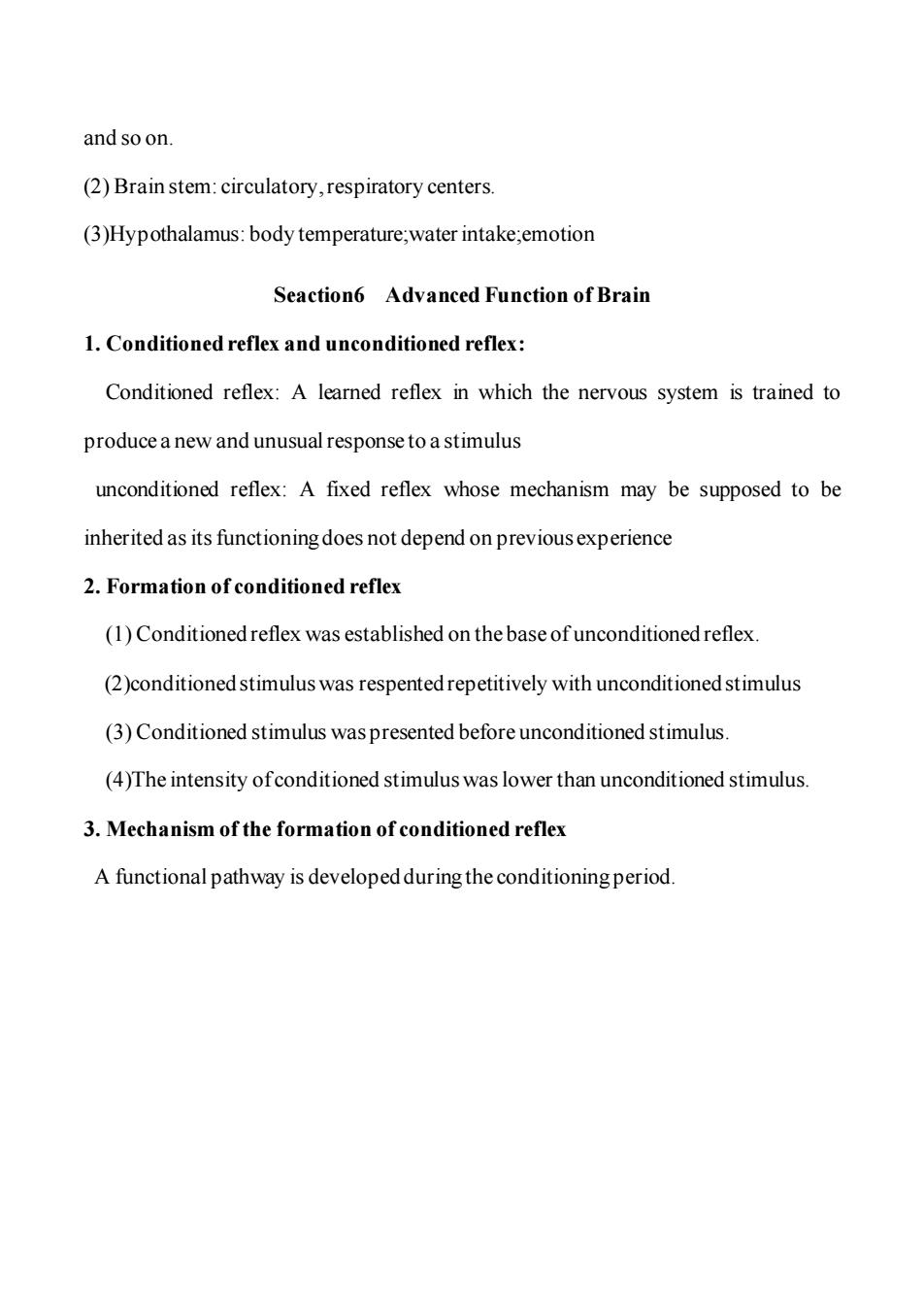
and so on. (2)Brain stem:circulatory,respiratory centers (3)Hypothalamus:body temperature;water intake;emotion Seaction6 Advanced Function of Brain 1.Conditioned reflex and unconditioned reflex: Conditioned reflex:A learned reflex in which the nervous system is trained to produce a new and unusual response to a stimulus unconditioned reflex:A fixed reflex whose mechanism may be supposed to be inherited as its functioning does not depend on previous experience 2.Formation of conditioned reflex (1)Conditioned reflex was established on the base of unconditioned reflex (2)conditioned stimulus was respented repetitively with unconditioned stimulus (3)Conditioned stimulus was presented before unconditioned stimulus. (4)The intensity ofconditioned stimulus was lower than unconditioned stimulus. 3.Mechanism of the formation of conditioned reflex A functional pathway is developed during the conditioning period
and so on. (2) Brain stem: circulatory, respiratory centers. (3)Hypothalamus: body temperature;water intake;emotion Seaction6 Advanced Function of Brain 1. Conditioned reflex and unconditioned reflex: Conditioned reflex: A learned reflex in which the nervous system is trained to produce a new and unusual response to a stimulus unconditioned reflex: A fixed reflex whose mechanism may be supposed to be inherited as its functioning does not depend on previous experience 2. Formation of conditioned reflex (1) Conditioned reflex was established on the base of unconditioned reflex. (2)conditioned stimulus was respented repetitively with unconditioned stimulus (3) Conditioned stimulus was presented before unconditioned stimulus. (4)The intensity of conditioned stimulus was lower than unconditioned stimulus. 3. Mechanism of the formation of conditioned reflex A functional pathway is developed during the conditioning period